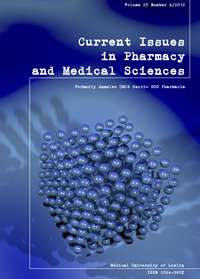Blood lipids and the risk of myocardial infarction
DOI:
https://doi.org/10.12923/j.2084-980X/25.4/a.15Keywords:
myocardial infarction, age, lipids, total cholesterol, HDL, LDL, triglyceridesAbstract
The most important risk factors for myocardial infarction include among other things, cholesterol (including LDL and HDL) and neutral fats - triglycerides. The aim of the research was the analysis of the levels of biochemical parameters in patients after myocardial infarction and without it on the risk of myocardial infarction. The study was conducted among patients suffering from ischemic heart disease, treated in five randomly selected primary healthcare facilities in Lublin. The study revealed that among patients with high levels of lipids (total cholesterol, LDL cholesterol, and triglycerides) the myocardial infarction is significantly more often observed, although there is a weak but statistically significant correlation between the level of triglycerides and HDL cholesterol concentration. Higher levels of triglycerides are accompanied by lower levels of HDL cholesterol. The variables having a statistically significant impact on the risk of heart attack are elevated levels of total cholesterol and low HDL cholesterol levels. High total cholesterol on average increases the risk of heart attack 3-fold compared to patients whose cholesterol level is normal. Patients with low levels of HDL cholesterol on average have a 2-fold higher risk of myocardial infarction as compared to patients whose concentration is higher than 35 mg%.
References
1. Baigent C. et al: Efficacy and safety of more intensive lowering of LDL cholesterol: a meta-analysis of data from 170,000 participants in 26 randomized trials. Lancet, 376. 1670, 2010.
2. Chapman M.J. et al: Triglyceride-rich lipoproteins and high-density lipoprotein cholesterol in patients at high risk of cardiovascular disease: evidence and guidance for management. Eur. Heart J., 32, 1345, 2011.
3. Cybulska B., Szostak W.B.: Dyslipidemia jako ważny czynnik ryzyka chorób sercowo-naczyniowych. Metody postępowania - Konsensus Rady Redakcyjnej PFP. Polskie Forum Profilaktyki Chorób Układu Krążenia (PFP), 2, 1, 2008.
4. Freiberg J.J. et al: Non-fasting triglycerides and risk of ischaemic stroke in the general population. JAMA, 300, 2142, 2008.
5. Mayers C.D., Kashyap M.L.: Pharmacologic elevation of high-density lipoproteins: recent insight on mechanisms of action and artheriosclerosis protection. Curr. Opin. Cardiol., 19, 366, 2004.
6. Reiner Z. et al: ESC/EAS Guidelines for the management of dyslipidaemias: The Task Force for the management of dyslipidaemias of the European Society of Cardiology (ESC) and the European Atherosclerosis Society (EAS). Eur. Heart J., 32, 1769, 2011.
7. Shepherd J. et al: Effect of lowering LDL cholesterol substantially below currently recommended levels in patients with coronary heart disease and diabetes: the Treating to New Targets (TNT) study. Diabetes Care, 29, 1220, 2006.
8. The Emerging Risk Factors Collaboration: Major lipids, apolipoproteins, and risk of vascular diseases. JAMA, 302, 1993, 2009.
9. Watała C.: Biostatystyka – wykorzystanie metod statystycznych w pracy badawczej w naukach biomedycznych. α medica press 2002.
10. Yusuf S. et al.: Effect of potentially modifiable risk factors associated with myocardial infarction in 52 countries (the INTERHEART study): case-control study. Lancet, 364, 937, 2004.
11. Zdrojewski T. et al.: Rozpowszechnienie głównych czynników ryzyka chorób układu sercowo-naczyniowego w Polsce. Wyniki badania NATPOL PLUS. Kardiol. Pol., 61(suppl. 4), 15, 2004.
Downloads
Published
Issue
Section
License
Copyright (c) 2025 Elżbieta Pietryka-Michałowska, Anna Walewska, Jolanta Szymańska (Autor)

This work is licensed under a Creative Commons Attribution-NonCommercial-NoDerivatives 3.0 Unported License.


